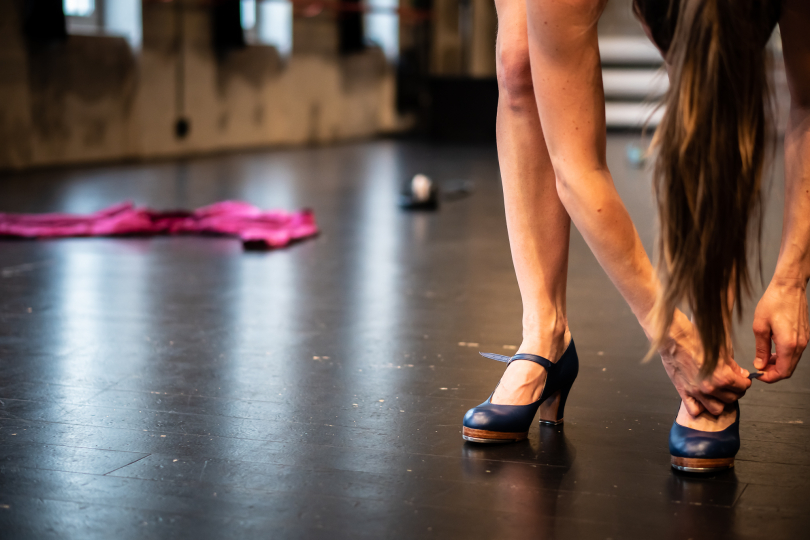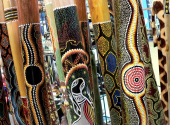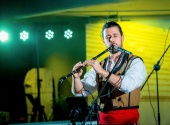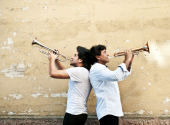
All Eyes on Norway with Janne Eraker: The Best Thing for Most Norwegians Would Be More Otherness
Janne Eraker is a tap dancer with a background in modern and contemporary dance. She uses her dancing body as a musical instrument and improvises with the rhythms and tonalities of tap dance. Eraker received a 3 year Artist grant from The Norwegian Arts Council (2015-2017) and is the first tap dancer to be included as a musician in the Norwegian Jazz Forum. She is currently working on an album for which she will collaborate with 11 musicians from various musical worlds. Though she calls herself "an outsider" and "a bit of a freak" who finds creative opportunities mostly in the underground scene, she has tapped her way into the hearts and address books of noise, jazz, folk, blues, and classical musicians. In this edition of Insounder's series on local music scenes, all eyes are on Norway!
What has it been like in Norway during the pandemic? Were musicians affected?
As a country, I think we’ve been pretty OK. There’s not much resistance to vaccinating, and now everything feels like it’s returning to some kind of normalcy. I have been lucky to receive some emergency/corona grants, I’ve been supported by the Alliance for Actors and Dancers—by the way, Creo, the union for arts and culture, is working on establishing an Alliance for Musicians as well!—and many jobs that got cancelled were still paid. In the music field, it’s been really hard for people who work in bigger events. The government came up with different compensation subsidies, but it’s been unreliable and unpredictable, and I know many musicians and venues are really fed up with dealing with this. And of course, we’ve had to deal with not being able to travel, sometimes even within the country.
What musical projects are you working on at the moment?
A LOT of them! Most importantly, I’m recording an album. It originated as a "corona-plan": the Ministry of Culture issued an open call for artists, offering to fund projects that could be realised under the pandemic circumstances. I envisioned that I would record 10 duets and trios with 11 different musicians, the connecting factor being me and my tap dance. This week, I am regularly meeting up with Anders Kregnes Hansen—a classically trained percussionist and composer—for sessions in which we brainstorm and improvise. Based on the material we create during this week, he will make a composition that we will record in June.
Other musicians I will collaborate with are electronic musician Kristoffer Lislegaard, steel guitarist Ivar Grydeland, banjo player Hans Martin Austestad, noise musician Harald Fetveit, blues guitarist Knut Reiersrud, vocalist Juliana Venter, drummer Michaela Antalova, pianist David Skinner, and my trusted colleagues Roger Arntzen (double bass) and Vegar Vårdal (violin) from my band One Small Step.
The goal of the album is to record tap dance in such a way that the audience hears it the same way I do as I am performing it. So, it’s partly a technical experiment in which we are searching for the appropriate microphones, microphone placement, and recording techniques. I know from experiences that it is almost impossible to amplify tap dance nicely and faithfully during a live concert. When I discussed this with sound engineer Morten Qvenild, he suggested that we would dive deep into this, maybe even construct a portable stage or platform that already has the microphones attached to it so that they are always ideally positioned and it’s just plug-and-play from there. That would be an amazing innovation, because I have honestly never been satisfied with the way my tap was amplified during live concerts, and it’s not always an option to perform acoustically.
What microphones did you use in the studio?
For the recording with Ivar, the set-up looked like this, from the bottom up: on the floor, we put a little carpet with a Crown P2M under it. Then, we put my tap dance boards (made of wood) on top of the carpet and attached a Yamahiko piano pickup contact mic to it. And finally, two Gefell 930 microphones and a WA-47 microphone on mic stands were used to pick up the sound from above.
Genre-wise, it sounds like the album is going to be extremely broad and varied.
Right! An important part of my project is to explore how to use tap dance according to the different collaborations. For instance, I want to create a different texture when I make music with a steel guitarist compared to when I work with a noise musician. I want to challenge myself to find specific ways of tap dancing that are meaningful in each specific blend. To get there, I need to know what the music needs, what I want to contribute to it, which possible sounds I have—including the possibilities and limitations of the recording techniques and room acoustics—but also how I tie back to or completely disconnect from traditional tap dance and all the references I have from there. And you are right, this will result in a broad and varied album.
As soon as I start imagining the process of sending the album out for reviews, I can already picture how those reviewers will criticise it for not having a clear enough focus or for not sticking to the genre that the reviewer is a connoisseur of. There is a clear focus though, which is the sound of tap dance, which I make, but that’s not easy for me, because I don’t really care about promoting myself as a solo artist. Do you know what I mean? My strength is in arctic research and connecting musicians for a common goal. In that phase, I am very capable of leading the project and putting into words exactly what we are doing and what we are looking for. But when I have to think about which font and colour palette to attach to my "image" (sighs)… I feel a certain resistance.
My plan is to press the album on vinyl. It’s a statement and a part of my project, to have tap dance on a record.
I always want to step "out of the box." There are not that many albums that have tap on them, and I think I’ve listened to them all. The tap scene stays very self-referential: all tap albums are always about tap. The titles and visuals of tap records are often about tap history, tributes to tap masters, the concept of tap-as-sound… Can you imagine that all albums made by guitarists would only be about the guitar? So, in taking tap seriously as a means of making music, I want to break free from that self-referentialism. But that makes it even harder to think of a good title for the album because a tap-pun would just be the obvious choice. Or to think of a good concept for the cover art… Tap albums often include a photo of the dancer with all their tap shoes or a typical, recognisable tap dance pose. And although I do want people to understand that this is what I do and they can expect a certain sound, I also want to communicate that it is not a traditional tap dance record.
Are Norwegian audiences open-minded when it comes to experimental music that transcends genre boundaries? Or are people divided into "scenes" that do not crossover all that much?
I’m under the impression that people are very loyal to their own genre here. But there are a few "wild boys" who keep stepping out of the box on principle, almost for show: "Look at me, I’m combining jazz with Oriental music, aren’t I wild!" (laughs) Anyway, the Norwegian jazz-and-improv scene is very small, I think that in the 4 years that I’ve been back, I’ve met almost everybody. People are a bit protective of their own "thing." But I’m a bit of a freak, you know, so it always takes a while for me to connect. If I have to explain verbally what I do, at a party or something, people don’t take me seriously. They just can’t understand it. So, I don’t even bother that much anymore to explain what I do, there’s no point—it’s better to invite them to a show and let them find out for themselves. Once people have seen me perform live, it’s possible to have great conversations, share common inspirations and think of great new ideas together.
In other words, for me to create a professional network and a following, I need to do it one individual at a time.
One of the ways that I get in touch with musicians is by organising a weekly training for all professional tap dancers in Norway—all five of them. (laughs) I lead those sessions and I often invite a musician to be a guest teacher alongside me.
And I have been organising a concert series called Salongen (the Salon), about 18 of them over the last 4 years, where tap dancers and musicians improvise together. It’s a spontaneous meeting, and we never know what’s going to happen! A great learning opportunity.
These activities have been successful—not in the least because I had a budget to pay out decent fees to all performers—and have helped me gain and strengthen some contacts.
I love those first encounters, improvising with somebody you don’t know yet. And although hosting those improvised concerts was always stressful and scary for me, I have learned a lot from it. I have seen people grow and have experienced magical moments. But now, I have come to a point where I feel saturated by those first encounters. It is time to focus on the relationships with the people I have already worked with and to go deeper.
What are good places in Oslo to meet musicians?
Well, my story might be a bit complicated. My background is in contemporary dance and that is my connection to Norway, because I studied dance here for a year before I moved to the Netherlands. During my time in the Netherlands, I always kept up with what was happening in Norway; leadership changes in dance companies, interesting projects, and so on. One time, I got wind of an open call for a seminar in Tromsø on the topic of sound and movement. I applied with a project I had at the time, creating improvised music with tap and bass guitar with Bruno F. X. da Silva (from Rotterdam), and we were selected. So, all of a sudden, I found myself spending an entire weekend in a theatre filled with like-minded spirits, nothing but people who worked with sound and movement, with music and dance. I basically got my network handed to me on a silver platter! In hindsight, I think that by now I have collaborated with almost everybody that I met during that seminar.
The people I met there were my gateway into various music scenes. For example, I met the noise musician Harald Fetveit there, and we later went on a tour to Japan. Because of that experience, the noise scene is now accessible to me. And this is something I have learned from talking to musicians: the dance scene here is a lot smaller than the music scene. There are fewer freelance performers who can make a living by dancing than by making music, but on the flip side, dance projects usually guarantee higher pay.
Dancers work project-based, and usually don’t start a project before it’s relatively decently financed, including a planned premiere and some shows. For example, dancers would never ask a musician to commit themselves to a week of rehearsals for free. It just goes without saying that they will be paid for rehearsals as well. Among musicians, it is much more common not to ask compensation for rehearsals and recording sessions, because it is seen as an investment that will be paid out during the tour to follow. But then again, dance projects often result in 2-3 performances, whereas music collaborations can go on for much longer.
For this reason, the professional musicians I have worked with have discovered that it is beneficial to collaborate with a dancer. If you sign up for a project with them for a certain amount of time, you know that you will be fairly compensated for the length of the project—including the time you spend creating and doing artistic research.
Some venues for music in Oslo that I can recommend are Kafé Hærverk, Mir, Kulturkirken Jakob, Blitz, Revolver, Riksscenen (folk), Rockefeller, Victoria Nasjonal jazzscene, and Herr Nilsen (Sunday jazz jam).
Imagine you were a band manager with a bottomless bag of money and the power to make everybody say "yes" to all your requests. If you were to book a "dream tour" through Norway, what would it look like?
I don’t know much about the more mainstream pop and rock scenes, so I’ll talk about jazz and underground, mostly. There are a lot of jazz festivals in beautiful places, for example Moldejazz. There’s also an organization for jazz musicians called Norsk jazzforum and they have a lot of small clubs all over Norway with a capacity of about 100. I know that’s how many jazz musicians in Norway book their tours. The Kongsberg Jazzfestival is controversial at the moment because they are sponsored by the Kongsberg Group that invests, among other things, in war weaponry. Many musicians boycott these festivals because of this. A group of activist-musicians have started their own Motvind Festival as an alternative.
Two other good festivals that come to mind are Fram Kunstfest and Ultima.
How about the folk scene?
There are venues that are dedicated to promoting Norwegian folk culture, such as the Riksscenen in Oslo. Norwegian traditional folk is a niche, but it is very politically correct at the moment, because you can’t go wrong with it, really. Both left-wing and right-wing politicians love it, so whichever way the wind is blowing, there is funding for that type of culture! (laughs) And thanks to that, it is of high quality.
There are a lot of musicians who play a traditional Norwegian instrument, such as the hardingfele [a violin with additional strings that serve as a drone, ed.], who have started using that instrument in an innovative way. That seems to be all the rage right now. As a tap dancer, I understand that it’s a big deal to consciously step out of a traditional scene that way.
What do you think the Norwegian music scene is lacking, that they might be eager to import?
Hmm… Thinking of the "Scandinavian modern jazz" scene, I think it’s because Norway is so far removed from everywhere and because it’s quite a wealthy country, musicians have the opportunity to do their own thing. They are not as pressured into commercialism and pleasing the crowds, and have the freedom to focus on "high art." But there are some downsides to that as well. It seems to me that the people in this scene can be very dismissive of anything and anyone that they don’t consider to be of enough "quality." When I was living in Rotterdam, I knew a lot more musicians who didn’t have any money but did their own thing, with a kind of punk mentality, more experimental and open-minded. Over here, prestige seems to be more of an issue, which makes them close some doors and refuse projects or collaborations that could have been interesting. I guess the best thing for most Norwegians—not only musicians, but everybody—is to get out in the world and be confronted more with "otherness."
What are some of Norway’s musical export products?
Allow me to quote Jazz in Europe: "The Scandinavian sound is generally recognized as free, spacious, experimental, and contemplative; it is consistently progressive, pioneering jazz most open to incorporating the newest electronic technology and improvisation; and it has also been more open to modern or contemporary classical music and collaborations with European folk and ethnic-musicians." I’m thinking of Jan Garbarek, Bugge Wesseltoft, Nils Petter Molvær, but also Silje Nergaard, and Mari Boine. The latter is our most famous representative of the Sami culture, and she’s been touring for years and years. It seems that now there is a new wave of younger Sami musicians and singers coming as well. Norwegian musicians are also strongly represented at some specific international festivals. For example, the festival Jazz Ahead in Germany devoted an entire day to Norwegian jazz. And that doesn’t magically happen, that’s because the Norwegian scene actively works on realising their "Nordic festivals" in other countries.
Let’s do some shameless namedropping! Which Norwegian artists are worth checking out?
That’s difficult to answer because I can be attracted to musicians for many different reasons, as I’m always very pragmatically exploring the possibility of collaborations. Some of the musicians I have a “crush” on are fresh out of the academy—I saw them at one of their recitals and was blown away by how much potential they have, but they haven’t released any albums yet or might not even have a website.
But to name a few…
- Stian Carstensen and his Farmer’s Market
- Jaga Jazzist, an experimental jazz band blending rock, jazz and electronic music. They are just amazing. The first time I saw them was in the Netherlands around 2002, and they are all over the world.
- Motorpsycho
- Karpe (pop music, world-famous in Norway)
- Maja S. Ratkje
- Kjetil Jerve
- MoE (and everything else Guro Moe is doing)
- POING
- Pinquins (percussion trio)
- Christian Meaas Svendsen
Is there anything that’s quite a big thing in Norway but that foreigners might never have heard of?
Danseband. It’s a Swedish genre, but it’s a thing in Norway as well. It’s kind of schlager that people dance to in pairs… It’s generally looked down upon, but it’s a thing, yeah. The opposite of "Scandinavian cool."
What surprised you when you came back to Norway after living in the Netherlands for many years?
That I couldn’t find any jazz musicians who were willing to jam over jazz standards from the American Songbook. They’d all dismiss it, saying “That’s old-fashioned, that’s not art, that’s not cool.” So I made my peace with that. And now, years later, if I meet someone who plays "Honeysuckle Rose", I’m like: "Whoa, you do that?! That’s so radical of you!" (laughs)
I’m working with a musician called David Skinner who plays ragtime songs and jazz standards, but in different measure types. He’s a virtuoso, so he can do anything he wants. He can play "Shiny Stockings" and make it into something completely absurd. And he is respected, but he might be the only one who can make that claim. By the way, he organises a concert series called Café Society, so that could be worth checking out for jazz musicians touring Norway. Café Society is not only a concert evening, but also a social dance event where people dance lindy hop. It's really cool, highly recommended.
What are your plans for releasing your album?
We will finish recording in October. For each track, we will make a behind-the-scenes video of the recordings, which we will start releasing on a monthly basis from November on, together with the respective recording. The album will eventually be released on vinyl in the fall of 2023.
If we want to know more about the Norwegian music scene, which music media should we check out to stay in the loop?
- The literature page of the Norsk Jazzforum
- Jazznytt and their blog Now's the Time
- salt peanuts*
- BluesAsylet on radio NRK
- Spillerom on radio NRK
- Jungeltelegrafen on radio NRK
If you have found an error or typo in the article, please let us know by e-mail info@insounder.org.





